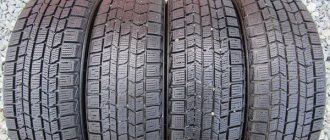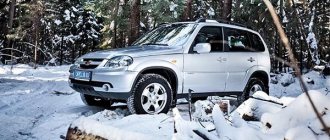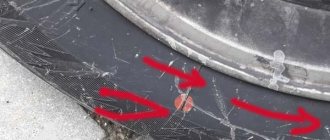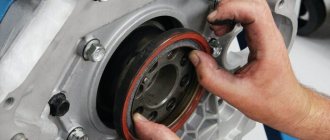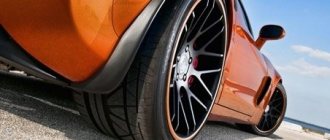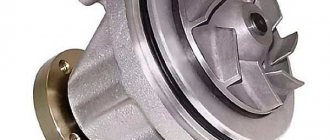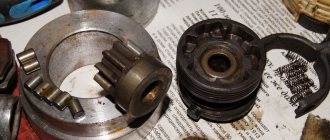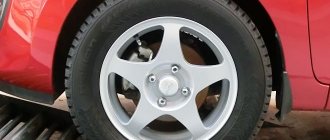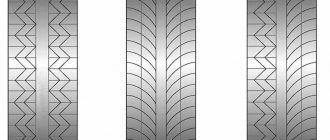Of course, the fact of dividing tires into summer, winter and all-season is not something new for readers of this article. But it is worth dispelling the misconceptions of many motorists regarding all-season tires.
The thing is that many manufacturers indicate “All Season” or “All Weather” on some of their tire models, which is popularly interpreted as “all-season.” Is it correct? Is it true that you can drive on such tires in winter and summer? And in general, are all-season tires applicable in the Russian Federation? Let's try to understand the issue.
Let's start with the fact that if there were tires that were suitable for the same use all year round, then there would be no point in producing summer and winter tires. Manufacturers could always use the same tires, and success would be guaranteed. Why doesn't this happen?
History of all-season tires
The first “all-season” model appeared in the late 70s in the USA, the model was called “Tiempo” and caused a lot of criticism and laughter. Literally a couple of years later, Goodyear releases its all-season tire model, which also receives sarcasm and criticism.
It would seem - why do tire manufacturers need such “success”? But no, in the 80s an all-season tire from Dunlop came out, which found its buyers in countries with temperate and mild climates. And after this, many tire manufacturers begin to produce all-season tires.
What tires are called all-season?
All-season tires mean products labeled All Season, All Weather, M+S, etc. However, despite the loud designations, they are such only in very specific climatic conditions. In particular, we are talking about regions where winter temperatures rarely fall below 0 °C, and summer temperatures do not exceed 25 °C.
For reference: the first all-season tires appeared back in 1977. It was Goodyear Tiempo. However, it did not gain much success, as did the next development of the company called Arriva, presented at the Winter Olympics in New York in 1980.
Why is this necessary?
Standard situation: a motorist has two sets of tires - winter and summer, which he changes twice a year, as soon as the average daily temperature crosses about +7 degrees Celsius or for some other reason. This is correct and safe (if the tread depth is working and the tires are in good condition).
And there is a certain group of “economists” who do not want to give money to a tire service twice a year . They are the first buyers of all-season tires. But how correct and safe is such a solution? Read on.
Advantages and disadvantages
So, the main advantages of all-season tires can be reduced to the following qualities:
- savings due to the fact that there is no need to buy two sets. In addition, they require storage, “changing shoes,” etc.;
- in winter, such tires certainly behave better than regular summer tires;
- Unlike winter studded ones, universal ones do not have such a high noise level.
Now it would be fair to note what are the disadvantages of such a solution:
- All-season tires do not guarantee such traction when moving on ice and snow;
- Such products are too hard in frosty weather, and are excessively soft in hot weather.
What do automakers think about this?
The all-season operating temperature range is from -10 to +10 degrees. All this is very conditional, but using all-season tires far beyond these limits is undesirable and sometimes dangerous. And in the specified temperature range there is often high humidity, which does not have the best effect on the car’s handling.
That is why cars, namely, “allow” the use of all-season tires. But it is advisable to use them on a dry and clean road, and developing decent speed on them is dangerous.
What does the law say about all-season vehicles?
As we all know, the Technical Regulations of the Customs Union “On the safety of wheeled vehicles” have been in force in Kazakhstan for many years now. According to paragraph 5.5 of Appendix No. 8 of this document, during the winter period (December, January, February), the operation of vehicles of categories M1 and N1 that are not equipped with winter tires that meet the requirements of paragraph 5.6.3 is prohibited.
Paragraph 5.6.3 states that in the eyes of the law, winter tires are considered not only tires with a sign in the form of a mountain peak with three peaks and a snowflake inside it, but also those marked with the letters M+S, M&S and M S. Please note that the designations All Season and All Weather are not on the list.
However, there are manufacturers who are outright cunning by producing models of all-season AT tires labeled M+S. Yes, by law you can drive them in winter, but, as practice shows, they cope very poorly with snow and ice when compared with a full-fledged “winter”.
1 / 2
Toyo Open Country A/T Plus are marked M+S…
...and toothy tread, but in winter they will still lose to real winter tires
1 / 2
All-season tire tread and its features
Since the “all-season” tire is a hybrid of “winter” and “summer”, its tread should, in theory, combine elements .
Typically, the tread of all-season tires has rounded sidewalls, which are found on summer wheels. But with the presence of wide grooves and dissected lamellas, the “all-season” one resembles winter ones.
The tread of winter tires has a high degree of self-cleaning, which is important when driving in snow. It has a large number of lamella blocks and a decent height (if we are not talking about Eurowinter).
Summer tires, on the contrary, have a low tread that will reliably “stick” to the asphalt surface. It does not require wide and deep grooves.
And here’s the question: how can such different types of patterns be combined in one tire? Answer: qualitatively - not at all . Well, you won’t get summer handling in the heat and winter performance in the snow at the same time. And the rubber composition of summer and winter tires is radically different. “All-season” will perform especially poorly in the heat of 30 degrees and in the cold of -20.
Summer tire in winter
These are tires for extremely warm temperatures, they should be rigid and relatively light, they should not have a rough and high tread, but effectively remove moisture. A hard tire in summer is a salvation, it “doesn’t melt or float” at above-zero temperatures, hard compounds are used to the maximum, heating up from hot asphalt, the tire effectively engages with the road surface, and there is no increased wear. However, in winter (already at zero), such rubber begins to harden, in addition to the fact that it itself is “hard,” under the influence of negative temperatures it becomes even harder, the tread cannot effectively adhere to the road surface (it practically does not wrinkle), and Even more so when dealing with snow or ice, such a tire literally rolls like “on skates”, the braking distance increases and the grip on the road deteriorates.
Maybe it would be more correct to call it “demi-season”?
In theory - yes. If you do not live on the equator or in the far north (at these points the temperature is the same all year), then you will not be able to get by with just one set of tires. Here, as with shoes, there is the concept of “demi-seasonality,” the moment of transition from autumn to winter and from spring to summer. It is during these periods that the temperature fluctuates in the above range (-10 +10 degrees) and you can confidently drive on all-season tires. But then you get “anti-savings” - you need to visit the tire shop even more often, and you need to have as many as three sets of wheels! So for our person this is not an option.
The markings on some models of all-season tires can confuse the car enthusiast. Often on their sidewall you can see the designation “M+S”, which in the driver’s head clearly turns into the words “dirt and snow”. Here it is - “winter all-season”! Not so.
Such a designation in itself does not make the tires winter. Winter tires have an icon on their sidewall in the form of a snowflake in a rock. "M+S" simply indicates that the tire has improved performance in wet mud or other uneven surfaces.
Main characteristics: size, profile, type and design of the tread
All-season tires, like regular tires, have the following parameters:
- Profile. The width and height indicators are taken into account. The width is in millimeters, and the height is a percentage of the width. For example, 205/55, where 205mm is the width of the tire, and 55 is % of 205, that is, 92.25 mm.
- Diameter of the seat. Measured in inches and depends on the car model. It is marked on the side of the wheel in the form of numbers (13, 15, 20, etc.).
- Design. It can be diagonal (rarely used) and radial. Denoted by the letters D and R respectively..
- The side is indicated on the asymmetrical treads. Marked with the inscriptions Inside and Outside. Directional wheels have an arrow indicating the direction and the words Rotation.
- Temperature conditions. Indicated in the letters A, B and C, where A is the best indicator of heat resistance at high speeds.
- Maximum pressure. Expressed in kilopascals or bars.
Related link:
Full description of tire markings
Special badges on all-season tires
External side marking
The manufacturer can apply to all-season and other additional descriptions, for example, the material from which the cord is made (nylon, polyester, steel) or the wear resistance of the rubber, which is expressed in numbers from 100 to 500.
Speed table
Speed indicators are indicated by letters. The marking indicates the ability of the tires to reach a particular speed.
| Maximum speed (km/h) | Speed index |
| 120 | L |
| 130 | M |
| 140 | N |
| 150 | R |
| 160 | Q |
| 170 | R |
| 180 | S |
| 190 | T |
| 200 | U |
| 210 | N |
| 240 | V |
| 270 | W |
| 300 | Y |
| More than 300 | Z |
Tire load table
The load index determines the carrying capacity of the vehicle
| Index | Weight, kg | Index | Weight, kg | Index | Weight, kg | Index | Weight, kg | Index | Weight, kg |
| 62 | 265 | 75 | 387 | 88 | 560 | 101 | 825 | 114 | 1180 |
| 63 | 272 | 76 | 400 | 89 | 580 | 102 | 850 | 115 | 1215 |
| 64 | 280 | 77 | 412 | 90 | 600 | 103 | 875 | 116 | 1250 |
| 65 | 290 | 78 | 425 | 91 | 615 | 104 | 900 | 117 | 1285 |
| 66 | 300 | 79 | 437 | 92 | 630 | 105 | 925 | 118 | 1320 |
| 67 | 307 | 80 | 450 | 93 | 650 | 106 | 950 | 119 | 1360 |
| 68 | 315 | 81 | 462 | 94 | 670 | 107 | 975 | 120 | 1400 |
| 69 | 325 | 82 | 475 | 95 | 690 | 108 | 1000 | 121 | 1450 |
| 70 | 335 | 83 | 478 | 96 | 710 | 109 | 1030 | 122 | 1500 |
| 71 | 345 | 84 | 500 | 97 | 730 | 110 | 1060 | 123 | 1550 |
| 72 | 355 | 85 | 515 | 98 | 750 | 111 | 1090 | 124 | 1600 |
| 73 | 365 | 86 | 530 | 99 | 775 | 112 | 1120 | 125 | 1650 |
| 74 | 375 | 87 | 545 | 100 | 800 | 113 | 1150 | 126 | 1700 |
What the tests say
Often, owners of crossovers and SUVs use all-season M+S tires all year round, considering them an ideal option. Additionally, this is facilitated by their confidence in the electronics of the all-wheel drive vehicle. Especially expensive and modern. They are confident that such a car will independently cope with icy roads, and that in the summer it will firmly hold on to the asphalt at high speed.
Electronics and all-wheel drive are certainly good things, but what the car is wearing plays a significant role in terms of handling. And here the “all-season” system loses greatly.
A bunch of tests carried out every year show that the all-season “M+S” on ice lags behind the “Velcro” in grip by 35-60%, on snow - by 30-80%. “Spikes” outperform her on ice by 90%, on snow by 35-85.
The gap is serious. On hard winter roads, winter tires are always more controllable than all-season tires, and they also demonstrate a smoother ride. In deep snow they “rakes” better, their braking distance is always shorter.
The same thing happens in comparison with summer tires.
Dimensions
The size of all-season tires produced depends on the vehicles they are intended for. So for SUVs and crossovers, the most popular ramps are from R16 to R23. Passenger cars use smaller diameter tires from R13 to R21. You can see the main tire sizes in the table below.
Table - Main dimensions of all-season tires.
| 13» | 175/70 R13 82R |
| 14» | 155/65R14 75R |
| 14» | 175/65 R14 86R XL |
| 14» | 185/65 R14 90R XL |
| 15» | 165/60 R15 81R XL |
| 15» | 175/65 R15 88R XL |
| 15» | 185/55 R15 86R XL |
| 15» | 185/60 R15 88R XL |
| 15» | 185/65 R15 92R XL |
| 15» | 195/55 R15 89R XL |
| 15» | 195/60 R15 92R XL |
| 15» | 195/65 R15 95R XL |
| 15» | 205/65 R15 99R XL |
| 16» | 195/50 R16 88R XL |
| 16» | 195/55 R16 91R XL |
| 16» | 195/60 R16 93R XL |
| 16» | 205/55 R16 91R Flat |
| 16» | 205/55 R16 94R XL |
| 16» | 205/60 R16 92R Flat |
| 16» | 205/65 R16 96R XL |
| 16» | 205/65 R16 99R XL |
| 16» | 215/55 R16 97R XL |
| 16» | 215/60 R16 99R XL |
| 16» | 225/50 R16 96R XL |
| 16» | 225/55 R16 99R XL |
| 16» | 225/60 R16 102R XL |
| 16» | 235/60 R16 104R XL |
| 17» | 205/50 R17 89R Flat |
| 17» | 205/50 R17 93R XL |
| 17» | 205/55 R17 95R XL |
| 17» | 205/55 R17 95R XL F |
| 17» | 215/40 R17 87R XL |
| 17» | 215/45 R17 91R XL |
| 17» | 215/50 R17 95R XL |
| 17» | 225/45 R17 91R Flat |
| 17» | 225/45 R17 94R XL |
| 17» | 225/50 R17 94R Flat |
| 17» | 225/50 R17 98R XL |
| 17» | 225/55 R17 101R XL |
| 17» | 225/55 R17 97R Flat |
| 17» | 235/45 R17 97R XL |
| 17» | 235/50 R17 100R XL |
| 17» | 235/55 R17 103R XL |
| 17» | 245/45 R17 99R XL |
| 18» | 225/40 R18 92R XL |
| 18» | 225/45 R18 95R XL |
| 18» | 225/45 R18 95R XL F |
| 18» | 235/50 R18 95R XL Flat |
| 18» | 225/50 R18 99R XL |
| 18» | 235/40 R18 95R XL |
| 18» | 235/45 R18 98R XL |
| 18» | 235/50 R18 101R XL |
| 18» | 245/40 R18 97R XL |
| 18» | 245/45 R18 100R XL |
| 18» | 245/50 R18 100R XL Flat |
| 18» | 245/50 R18 104R XL |
| 18» | 255/45 R18 103R XL |
| 19» | 155/70 R19 88Q XL |
| 19» | 255/40 R19 93R XL |
| 19» | 225/45 R19 96R XL |
| 19» | 245/35 R19 93R XL |
| 19» | 245/40 R19 98R XL |
| 19» | 255/45 R19 102R XL |
| 19» | 255/35 R19 96R XL |
| 19» | 255/40 R19 100R XL |
| 19» | 255/45 R19 104R XL |
| 20» | 195/55 R20 95R XL |
| 20» | 245/40 R20 99R XL |
| 20» | 255/35 R20 97R XL |
| 20» | 285/30 R20 99R XL |
| 21» | 245/35 R21 96R XL |
“All-season” for SUVs
“What about All Terrain or Mud Terrain tires?” an inquisitive reader will ask. “They are for year-round use!” Yes it is. But who are these tires for?
For example, some of the best in this segment - BF Goodrich All Terrain T/A KO and BF Goodrich Mud Terrain T/A KM2 are designed for off-road SUVs, which carry out most of their travel in real off-road conditions.
Are you a fan of mud rallying? And do you have a real frame SUV (like a Patriot )? Then these tires are for you. Or is your movement “work-shop-home”? Occasionally - a dacha. In this case, “all-season” will not suit you.
Disadvantages of “all-season”
But along with all the advantages, there are also certain disadvantages that such tires have:
- All-season tires are unsuitable for use at temperatures below 7 degrees below zero, as they harden and lose their elasticity.
- Despite the special tread pattern, it copes with icy and snowy roads worse than its winter counterparts.
- Wears out quickly.
Thus, all-season tires have advantages and disadvantages, which are very important to consider when choosing products. It is also necessary to take into account the conditions in which the tires are intended to be used. For those who primarily travel around the city, you can buy almost any tire. For fans of high-speed driving, all-season tires may not be suitable, since when driving too fast they do not provide sufficient stability and precision control. This can be fraught with dire consequences, so do not neglect basic recommendations.
All-season tires in Russia
To summarize the above, we repeat - for most regions of the Russian Federation, “all-season”, alas, is not suitable . But what then is the reason for the certain popularity of these tires among domestic car owners?
This is not only a desire to save money and time. The fact is that some serious automakers equip their cars with all-season tires on the assembly line. They do this so that the dealer can sell products at any time of the year. That’s why you can see new foreign cars on the streets “shod” with all-season tires.
Well, our people’s love for off-road cars, when choosing tires for which, the issue of seasonality fades into the background, cross-country ability comes to the fore, which pushes us to buy “M+S” tires.
General rules for choosing car tires
It is almost impossible to answer unequivocally which tires are best. When choosing, you should look at the operating features and driving style. The technical requirements of the car are taken into account, because the wheel and tire must easily fit into the fender liner.
It is worth understanding the markings of tires. Let's see, for example, what this designation says: 175/65R14 86H. This marking is deciphered as follows.
- 175 – profile width in mm.
- 65 – ratio of profile height to its width. Shown as a percentage.
- R – radial design.
- 14 – internal landing diameter.
- 86 – permissible load index.
- H – index demonstrating maximum speed.
There are no special requirements for all-season tires. First of all, you should look at the data specified in the operating manual for your car.
All-season tires are not a complete replacement for winter or summer tires. It should only be used in mild winter conditions. When choosing, take into account the operating characteristics, as well as the nuances of the road surface.
